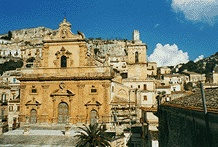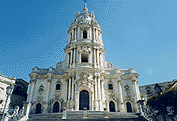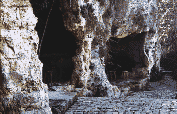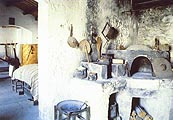| |
 MODICA:a town with one hundred churches MODICA:a town with one hundred churches It is a town with one hundred bells and
one hundred churches which in the fourteenth century for
its power and beauty was a kingdom inside the kingdom.
The County was founded on march 25th 1296 when
Manfredi di Chiaramonte was given the kingdom after the
King of Sicily Federico II was crowned. The golden age of
the County managed to dim even the power and the
magnificence of the Kingdom of Sicily. The works of art
are what is left today of that economic power and glory.
Today Modica is one of the kingdoms of baroque art and of
all the artistic jewels of Sicily. It is a town with one hundred bells and
one hundred churches which in the fourteenth century for
its power and beauty was a kingdom inside the kingdom.
The County was founded on march 25th 1296 when
Manfredi di Chiaramonte was given the kingdom after the
King of Sicily Federico II was crowned. The golden age of
the County managed to dim even the power and the
magnificence of the Kingdom of Sicily. The works of art
are what is left today of that economic power and glory.
Today Modica is one of the kingdoms of baroque art and of
all the artistic jewels of Sicily.
Placido Garrafa wrote: "Modica looks like an eagle
– everybody knows it as Motuca for its ancient
story, some think its origin is unknown because it is too
old, and the beginning of its foundation is lost in memo ry." The
town is full of architectural beauties, imposing and
wide; in the town centre it is crowned by a steep spur,
where the Castle of the Counts stands out. It stretches
out in three Y shaped valleys, this geomorphologic
characteristic distinguishes it and makes the views from
above very spectacular. If driving by night on the Ponte
Guerrieri, on the road the links the town to Ragusa, you
look downward, you will see something which resembles a
splendid crib. Houses rise in terraces, join in the
slopes and almost hidden gardens often appear between
them. ry." The
town is full of architectural beauties, imposing and
wide; in the town centre it is crowned by a steep spur,
where the Castle of the Counts stands out. It stretches
out in three Y shaped valleys, this geomorphologic
characteristic distinguishes it and makes the views from
above very spectacular. If driving by night on the Ponte
Guerrieri, on the road the links the town to Ragusa, you
look downward, you will see something which resembles a
splendid crib. Houses rise in terraces, join in the
slopes and almost hidden gardens often appear between
them.
 The churches of St. Peter and St. Georges The churches of St. Peter and St. Georges
 Two churches out of one hundred are worth
mentioning in Modica. The late baroque church of St.
Peter in Corso Umberto is the most important work of the
lower quarter of the town. Here we find the same
magnificence as in Noto, in the long flight of step
bordered by the statues of the twelve Apostles. At the
top of the flight of step, the fašade of the church
reveals a particular model of decorative conception. The
interior of the church, with a nave and two lateral
aisles, preserves sublimes works like the statues of St.
Peter and the paralytic by Benedetto Civiletti and the
wooden statues of Pietro Padula. Two churches out of one hundred are worth
mentioning in Modica. The late baroque church of St.
Peter in Corso Umberto is the most important work of the
lower quarter of the town. Here we find the same
magnificence as in Noto, in the long flight of step
bordered by the statues of the twelve Apostles. At the
top of the flight of step, the fašade of the church
reveals a particular model of decorative conception. The
interior of the church, with a nave and two lateral
aisles, preserves sublimes works like the statues of St.
Peter and the paralytic by Benedetto Civiletti and the
wooden statues of Pietro Padula.
 The
church of St. Georges, has an imposing and stately
fašade too, at the top of a slope that forms a nice
natural balcony. From the top of the 250 steps you can
enjoy the plasticity of the three orders fašade. Inside
the church there is a silver urn containing some relics
of St. Georges, donated by the church to the powerful
Chiaramonte family. The story of this dynasty and of the
province is the same story of the county which this year
has celebrated the seventh centenary of its foundation. The
church of St. Georges, has an imposing and stately
fašade too, at the top of a slope that forms a nice
natural balcony. From the top of the 250 steps you can
enjoy the plasticity of the three orders fašade. Inside
the church there is a silver urn containing some relics
of St. Georges, donated by the church to the powerful
Chiaramonte family. The story of this dynasty and of the
province is the same story of the county which this year
has celebrated the seventh centenary of its foundation.
 History and culture History and culture
The legend says that Modica was
founded by Hercules the Egyptian. It is sure that the
Siculi chose it for its singular position that made it an
impregnable fortress.  The Ispica’s gully, the magnificent
and spectacular canyon carved in the Hyblaean tableland
is partly in the rural territory of Modica. So, the story
of the gully also belongs to the story of Modica. The Ispica’s gully, the magnificent
and spectacular canyon carved in the Hyblaean tableland
is partly in the rural territory of Modica. So, the story
of the gully also belongs to the story of Modica.
Its ancient name was Motyca; its power, dimmed by Greek
and Byzantine domination, broke out with all its vitality
during the Arabian domination, the Arabs called it Mohac.
With the Chiaramonte dynasty domination, Modica played a
leading role in the Reign. Many works of art show today
the signs of the Gothic-Chiaramonte style of the Counts
of Modica: the church of the Madonna del Carmine, Palazzo
Lena and the church of Ges¨. The convent annexed to this
latter church was built to solemnize the marriage between
Anna Cabrera and Henriquez. The wonderful internal
cloister has been declared a national monument.
 The town which
is the birth place of the famous poet Salvatore
Quasimodo, also boasts one of the most interesting
ethnical and anthropological museums in Sicily. The town which
is the birth place of the famous poet Salvatore
Quasimodo, also boasts one of the most interesting
ethnical and anthropological museums in Sicily.
"The Museum of Art and Popular Traditions",
dedicated to S. A. Guastella, is on the first floor of
the ancient convent of the Mercedari fathers, an
eighteenth century elegant and sober palace in a late
baro que
and rococo style. The museum is a mirror of ancient
crafts and rural civilisation, the cradle of local
traditions. The County was, and is still today, an
inexhaustible source of very ancient traditions,
religious rites and customs where things sacred and
profane, faith and superstition, merge. que
and rococo style. The museum is a mirror of ancient
crafts and rural civilisation, the cradle of local
traditions. The County was, and is still today, an
inexhaustible source of very ancient traditions,
religious rites and customs where things sacred and
profane, faith and superstition, merge.
|